Fuel Tank Replacement Front
Tools Required
| • | J 41416 Ultrasonic Leak Detector |
| • | J 45038 CNG Tank Lifting Fixture |
| • | J 45529 CNG Tank Lifting Bar |
Removal Procedure
- Relieve the CNG fuel system pressure. Refer to Fuel Pressure Relief .
- Disconnect the negative battery cable. Refer to Battery Negative Cable Disconnection and Connection in Engine Electrical in the G Van Service Manual.
- Remove the fuel tank shield. Refer to Fuel Tank Shield Replacement .
- Vent the CNG fuel from the CNG fuel tank if necessary. Refer to Fuel Tank Venting .
- Disconnect the electrical connectors at the high pressure lock-off solenoid as necessary.
- Disconnect the fuel outlet line (4) from the high pressure lock-off (HPL) solenoid (2).
- Disconnect the fuel inlet line (4) at the high pressure lock-off solenoid fitting (6).
- Place the J 45038 using a suitable lifting device such as a transmission lift jack beneath the tank to be removed ensuring placement is between the tank straps.
- Remove and discard the retaining nut and bolt (5).
- Remove the tank strap upper mounting pins (3).
- Remove the tank straps (4) from the vehicle.
- Lower the fuel tank from the vehicle.
- Remove the tank from the lift jack using the J 45529 and a suitable lifting device.
Caution: Unless directed otherwise, the ignition and start switch must be in the OFF or LOCK position, and all electrical loads must be OFF before servicing any electrical component. Disconnect the negative battery cable to prevent an electrical spark should a tool or equipment come in contact with an exposed electrical terminal. Failure to follow these precautions may result in personal injury and/or damage to the vehicle or its components.
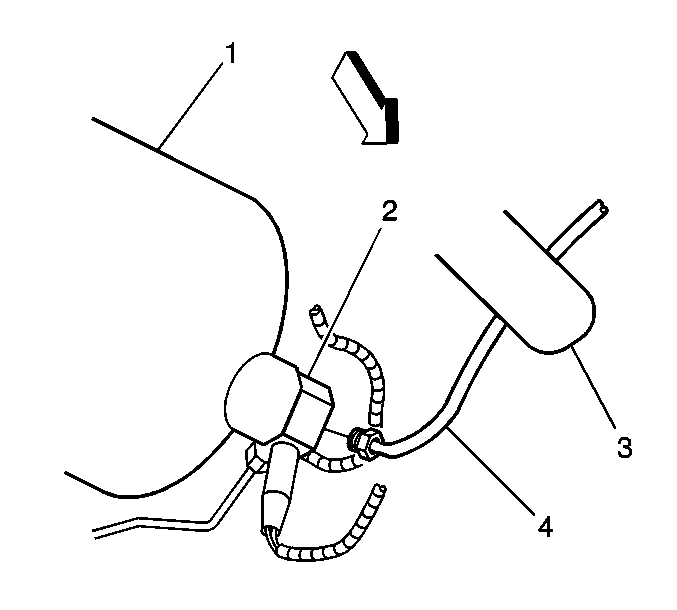
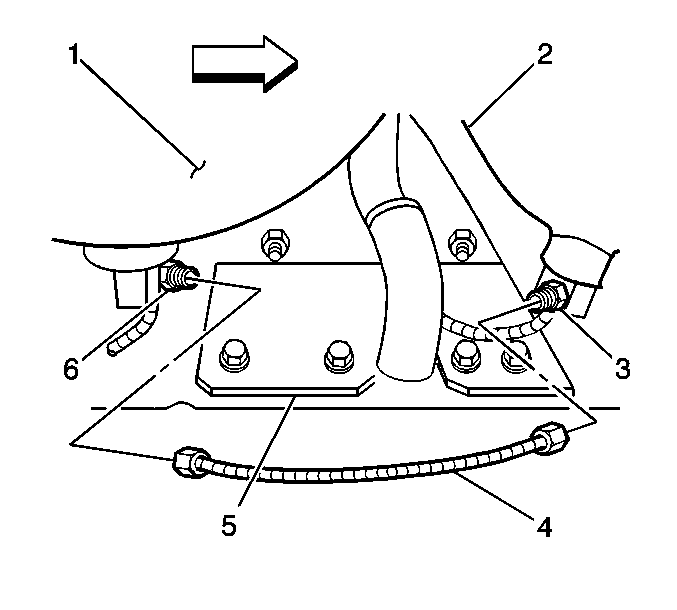
Important: The front and rear fuel tanks are not interchangeable. Mark the tanks as front and rear prior to removal from the vehicle.
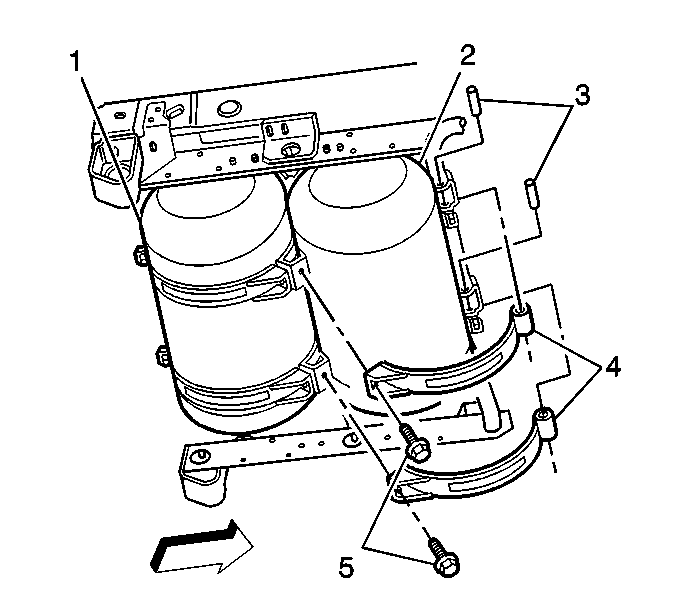
Installation Procedure
- Position the tank onto the lift jack using the J 45529 and a suitable lifting device.
- Raise the fuel tank into the tank mounting frame ensuring that the high pressure lock-off solenoid is properly oriented to the fuel lines.
- Place the straps (4) into the tank mounting bracket.
- Install the tank strap upper mounting pins (3).
- Install the new tank strap mounting nuts and bolts (5).
- Connect the fuel inlet line (4) at the front tank (1) high pressure lock-off solenoid fitting (6) using new O-rings. Lubricate the O-rings with petroleum jelly or equivalent.
- Connect the fuel outlet line (4) to the high pressure lock-off (2) using new O-rings. Lubricate the O-rings with petroleum jelly or equivalent.
- Connect the electrical connectors at the high pressure lock-off solenoid as necessary.
- Connect the negative battery cable. Refer to Battery Negative Cable Disconnection and Connection in Engine Electrical in the G Van Service Manual.
- Prime the CNG fuel system by cycling the ignition ON and OFF several times.
- Start the engine and use the J 41416 in order to inspect for CNG fuel system leaks at each serviced fitting.

Notice: Use the correct fastener in the correct location. Replacement fasteners must be the correct part number for that application. Fasteners requiring replacement or fasteners requiring the use of thread locking compound or sealant are identified in the service procedure. Do not use paints, lubricants, or corrosion inhibitors on fasteners or fastener joint surfaces unless specified. These coatings affect fastener torque and joint clamping force and may damage the fastener. Use the correct tightening sequence and specifications when installing fasteners in order to avoid damage to parts and systems.
Tighten
Tighten the tank strap mounting bolts to 47 N·m (35 lb ft).

Tighten
Tighten the fitting to 37 N·m (27 lb ft).

Tighten
Tighten the fitting to 37 N·m (27 lb ft).
Fuel Tank Replacement Rear
Tools Required
| • | J 41416 Ultrasonic Leak Detector |
| • | J 45038 CNG Tank Lifting Fixture |
| • | J 45529 CNG Tank Lifting Bar |
Removal Procedure
- Relieve the CNG fuel system pressure. Refer to Fuel Pressure Relief .
- Disconnect the negative battery cable. Refer to Battery Negative Cable Disconnection and Connection in Engine Electrical in the G Van Service Manual.
- Remove the fuel tank shield. Refer to Fuel Tank Shield Replacement .
- Vent the CNG fuel from the CNG fuel tank if necessary. Refer to Fuel Tank Venting .
- Disconnect the electrical connectors at the high pressure lock-off solenoid as necessary.
- Disconnect the fuel outlet line (4) from the high pressure lock-off (HPL) solenoid fitting (3).
- Disconnect the fuel inlet line (5) at the check valve fitting (4).
- Place the J 45038 using a suitable lifting device such as a transmission lift jack beneath the tank to be removed ensuring placement is between the tank straps.
- Remove and discard the retaining nuts and bolts (4, 5).
- Remove the tank strap upper mounting pins (2).
- Remove the tank straps (3, 6) from the vehicle.
- Lower the fuel tank from the vehicle.
- Remove the tank from the lift jack using the J 45529 and a suitable lifting device.
Caution: Unless directed otherwise, the ignition and start switch must be in the OFF or LOCK position, and all electrical loads must be OFF before servicing any electrical component. Disconnect the negative battery cable to prevent an electrical spark should a tool or equipment come in contact with an exposed electrical terminal. Failure to follow these precautions may result in personal injury and/or damage to the vehicle or its components.

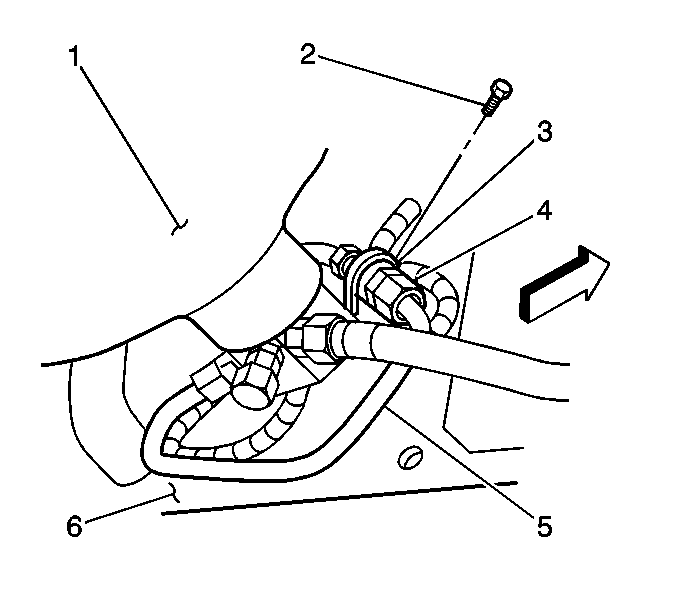
Important: The front and rear fuel tanks are not interchangeable. Mark the tanks as front and rear prior to removal from the vehicle.
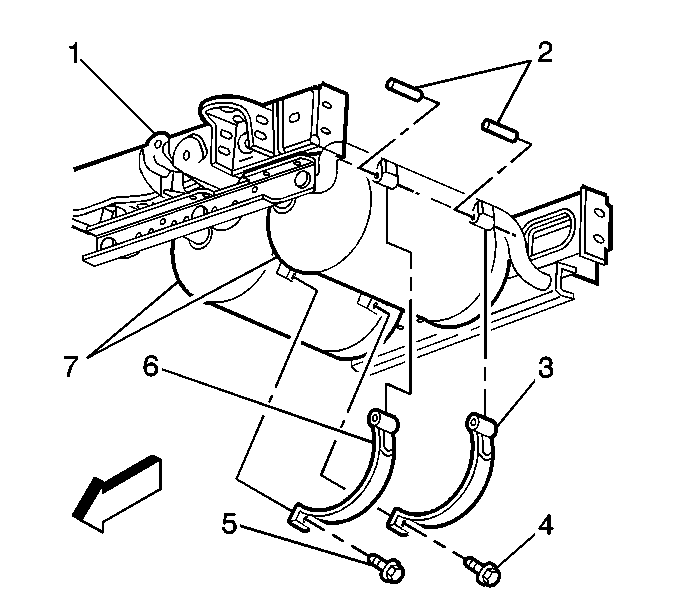
Installation Procedure
- Position the tank onto the lift jack using the J 45529 and a suitable lifting device.
- Raise the fuel tank into the tank mounting frame ensuring that the high pressure lock-off solenoid is properly oriented to the fuel lines.
- Place the straps (3, 6) into the tank mounting bracket.
- Install the tank strap upper mounting pins (2).
- Install the new tank strap mounting nuts and bolts (4, 5).
- Connect the fuel inlet line (5) at the check valve fitting (4) using new O-rings. Lubricate the O-rings with petroleum jelly or equivalent.
- Connect the fuel outlet line (4) to the high pressure lock-off fitting (3) using new O-rings. Lubricate the O-rings with petroleum jelly or equivalent.
- Connect the electrical connectors at the high pressure lock-off solenoid as necessary.
- Connect the negative battery cable. Refer to Battery Negative Cable Disconnection and Connection in Engine Electrical in the G Van Service Manual.
- Fill the CNG fuel system.
- Start the engine and use the J 41416 in order to inspect for CNG fuel system leaks at each serviced fitting.

Notice: Use the correct fastener in the correct location. Replacement fasteners must be the correct part number for that application. Fasteners requiring replacement or fasteners requiring the use of thread locking compound or sealant are identified in the service procedure. Do not use paints, lubricants, or corrosion inhibitors on fasteners or fastener joint surfaces unless specified. These coatings affect fastener torque and joint clamping force and may damage the fastener. Use the correct tightening sequence and specifications when installing fasteners in order to avoid damage to parts and systems.
Tighten
Tighten the tank strap mounting bolts to 47 N·m (35 lb ft).

Tighten
Tighten the fitting to 37 N·m (27 lb ft).

Tighten
Tighten the fitting to 37 N·m (27 lb ft).
